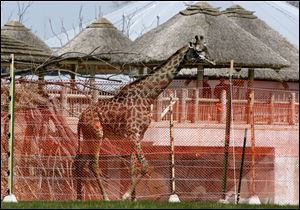
Toledo Zoo euthanizes 12-year-old lame giraffe
8/17/2012
Mowgli, the giraffe that was euthanized Thursday, was part of the Toledo Zoo's African exhibit.
The Toledo Zoo has euthanized Mowgli, its sole male Masai giraffe, because of a chronic hip condition that no longer could be managed with medication, according to the zoo's executive director.
"About 16 months ago, we noticed that he had a little bit of a limp," said Jeff Sailer, who joined the Zoo Aug. 1 from the City Zoos with the Wildlife Conservation Society, in New York, where he was director. "We have been watching it and giving him pain killers, but it became clear in April that he was not improving and the analgesics were not working."
The zoo then brought in a large-animal veterinarian as a consultant who confirmed something was going on with the giant mammal's femur. He suggested they continue to manage it with medication until the giraffe's quality of life began to suffer, then euthanize him, which the zoo did Thursday morning.
Mowgli's treatment included medication to ease inflammation as well as relieve discomfort. Additionally, he received a joint supplement and injections into his hip joint.
"The staff is pretty upset," Mr. Sailer said. "But if you care about an animal, it's the right thing to do."
Mowgli, who was 12, was middle-aged for a giraffe. He was about 17 feet tall and weighed about 2,400 pounds.
Amputation is not possible with large mammals such as giraffes since it would result in rapid deterioration of the other hip and legs, Mr. Sailer said.
"With large, heavy animals like giraffes, debilitating lameness of any kind is a very difficult issue to treat successfully," said Dr. Chris Hanley, the zoo's chief veterinarian.
Mowgli was anesthetized first and then euthanized. During the necropsy, which took between three and four hours, many tissue, lymph node, and organ samples were taken. The samples will be studied by pathologists and veterinarians around the country, Mr. Sailer said.
Preliminary necropsy results indicate a deteriorating, untreatable hip condition.
The remains of Mowgli, which were in many pieces because of the necropsy, were buried at the city's landfill in a site that was specially prepared and separate from where trash is deposited, Mr. Sailer said.
The treatment of an animal's remains are decided on a case-by-case basis, according to a zoo spokesman. Treatment of remains depends on each animal and the circumstances surrounding its death. For many animals, necropsy utilizes virtually all of the remains. Cremation is sometimes an option.
"Other times, we do save some remains for our biofact collection [animal-related items that we use to educate the public] or for scientific research to increase our understanding of animal care and conservation of animals in the wild," said Kandace York, zoo spokesman. "Regardless of the treatment of an animal's remains, it is a careful and respectful decision. We did save some of Mowgli's remains, which will be evaluated for educational and scientific value. However, out of respect for an animal's keepers, we have a waiting period in place before a biofact is introduced to our collection or utilized in any educational program."
Mowgli was born at the Toronto Zoo in 2000 and came to the Toledo Zoo in late 2001. He lived in the Zoo's multispecies African exhibit since its opening in 2004. The Zoo's other three Masali giraffes, all females, include his one-year-old daughter, Tuli; her mother, Elvira; and an unrelated female, Charlotte. Tuli, born on July 23, 2011, was the youngest giraffe at the zoo.
Mowgli and Elvira had another son, Enzi, who was born at the zoo Dec. 26, 2009. He was transferred to The Wilds in southern Ohio last fall.
It's unlikely that the remaining giraffes in the herd will react psychologically to Mowgli's disappearance, Mr. Sailer said.
The zoo will begin looking for another male -- or "bull" -- to bring into the exhibit, he said.
"Fortunately, there are a lot of young bulls that need homes," Mr. Sailer said.
Masai giraffes are the Earth's tallest animal species. When full grown, they stand 16 to 18 feet tall and can run at speeds of up to 35 mph.
Contact Tanya Irwin at: tirwin@theblade.com or 419-724-6066.